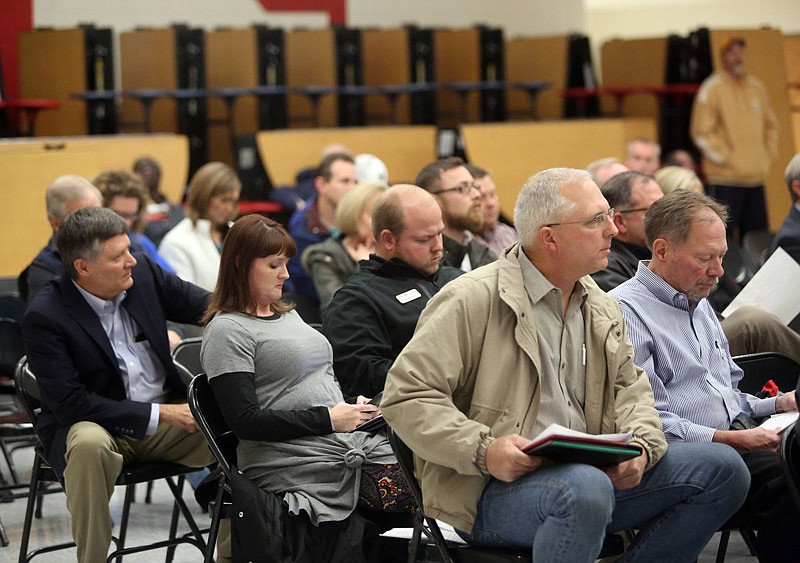The Jefferson City Public Schools district has a lower tax levy than two-thirds of the other districts in the state, according to data from the Missouri Department of Elementary and Secondary Education (DESE).
While few local voices have publicly criticized the district's current or proposed tax rate, the JCPS board is explicitly concerned Jefferson City residents will only be willing to pay for so much when it comes to what, if any, construction or renovation proposals they place on the April 4 ballot.
Increasing the levy to pay for a new second high school and renovations to the existing high school, as well as new and continuing operating costs, would mean the JCPS district's levy would be somewhere in the top 20 percent of the state.
Jefferson City's current school levy is $3.6928. The proposed $1.20 total levy increase being considered for the April 4 ballot would bring that up to $4.8928. A school levy is part of the overall property tax rate in a municipality, which is multiplied by a hundreth of a property's assessed value to calculate how much a property owner owes.
Essentially, if passed, the average Jefferson City homeowner could expect to pay about $26 more per month in property taxes if the school levies are approved.
What will district residents pay if levies pass?
Two separate votes are being considered for the April 4 ballot. The first is a 65-cent property tax increase to pay for the bond issue covering construction and renovation costs of the two-high school plan. The second vote is a combined 55-cent levy, which respectively covers operating costs for a second high school (25-cent levy) and operating needs for the current JCPS system (30-cent levy).
To calculate how much this might cost a homeowner, one must understand how property taxes work.
Taxes levied are based on this formula: assessed value of a home, divided by 100, then multiplied by the overall tax rate.
According to the Cole County Assessor's Office, the assessed value of a property is the number obtained by multiplying the market value (or appraised value) of the property by an assessment rate for that type of property. For residential homes here, that rate is 19 percent, and for commercial properties, it is 32 percent.
For example, a home valued at $139,000 - what the district has said is the market value of an average Jefferson City home - would have an assessed value of $26,410. Divide this number by 100, and it's $264.10.
The current tax rate in Jefferson City for a residential home is $4.9144, including the existing $3.6928 school levy, as well as additional city and county levies.
So a Jefferson City family that currently owns a $139,000 home would pay about $1,298 in property taxes annually, or about $108 a month. This payment is in addition to any other financial arrangement on the home, like a mortgage.
Increasing the school levies by the proposed $1.20 means the total tax rate for a residential home in the city would be $6.1144. Doing the math under this tax rate means the same family in the same average Jefferson City home would pay almost $1,615 a year in property taxes.
This means the homeowner would pay about $26 more a month in property taxes if the levies are approved.
How does JCPS tax rate stack up?
The News Tribune used data from DESE - up to date as of Dec. 21 - to determine the JCPS district's current tax levy rate ranks:
- 347th out of 518 school districts in the state,
- Third out of six similar-sized districts in the state,
- Sixth out of seven of local districts in central Missouri, and
- Fourth out of five districts that have some of the highest rates of students who receive free or reduced lunches.
Who has highest tax rate? Where does Jefferson City place?
At a rank of 347 out of 518, Jefferson City is nowhere near the top of the list in terms of the highest school district tax rates in the state.
In other words, almost 67 percent more districts - two-thirds of those in the state - have higher tax rates than JCPS does now.
The Center 58 district in Kansas City has the highest base rate, at $6.7828. Taking into account the Special School District Levy from St. Louis County would actually move Hazelwood from second place into first, though, to $7.8222.
DESE's data does not take into account a special school district levy St. Louis County districts pay on top of their local tax rate. That additional St. Louis County levy is $1.2348, which exists to pay for the educational needs of children with disabilities.
The rest of the top 10 would change a bit, too, when considering the special St. Louis County levy, with Normandy Schools Collaborative and Maplewood-Richmond Heights also located in county.
Jefferson City is low enough on the list its current position is not affected by any other shifts after taking into account the St. Louis County levy.
In its current spot on the list with its $3.6928 tax rate, Jefferson City is in the company of school districts Bevier C-4 ($3.7187; west of Macon), Cooter R-4 ($3.6592; in the far southeastern panhandle near the Arkansas and Tennessee borders), Davis R-12 ($3.6735; southwest of Clinton), Gasconade County R-1 ($3.7149; Hermann), Gasconade C-4 ($3.7042; Falcon, east of Lebanon), Joplin ($3.66), Kelso C-7 ($3.6932; south of Cape Girardeau) and Thayer R-2 ($3.6702; near the Arkansas border in the south central part of the state) - in addition to its neighbors in Blair Oaks and Eugene.
While rural school districts often take in students from an area larger than one town or village, here is some perspective in terms of local overall population numbers - not just students - according to the U.S. Census Bureau (as of 2015):
- Bevier: 703
- Cooter: 442
- Henry County (where Davis R-12 is based; it should be noted Davis R-12 is only K-8): 21,737
- Hermann: 2,376
- Laclede County (where Falcon is located): 35,473
- Joplin: 51,618
- Scott County (where Kelso C-7 is based): 39,008
- Thayer: 2,245
Jefferson City has a population of 43,169.
Adding the projection for where Jefferson City would be if the $1.20 total school levy increase passes is more complicated.
The $4.8928 rate would move Jefferson City far enough up the list the special school levy on St. Louis County districts would skew exact results - some districts would move up in the rankings if the special levy is calculated along with DESE's data, necessitating other districts to move down the list. But the Jefferson City rate would rank somewhere around the top 100.
What about districts of similar size?
Both JCPS Superintendent Larry Linthacum and Jason Hoffman, chief financial and chief operating officer,told the News Tribune comparing school districts based on similar sizes of student populations was an accurate measurement.
Documents from JCPS were also used to identify school districts of similar size to Jefferson City. The documents included tax rate comparisons with districts with average daily attendance numbers ranging from just over 5,000 students to more than 14,000. The same documents list JCPS' average daily attendance number at 8,015 students.
Comparing JCPS with other districts based on student body-size, the News Tribune made its cut-off roughly at plus or minus 2,000 students. Hoffman agreed this was an accurate measure to take, adding the district also gathered wide spread data to begin with.
Student populations plus or minus 2,000 students from Jefferson City's numbers bring in the Raytown C-2 (in the Kansas City metropolitan area), Joplin, Ferguson-Florissant R-2 and Mehlville R-9 (in the southern St. Louis metro area) districts for comparison.
In terms of other specific districts to compare based on size, Hoffman mentioned one other district to be considered.
"We've been using St. Joseph more recently since Brian Shindorf came to us," Hoffman said.
Shindorf is JCPS's director of elementary of education. He came to the district in 2016, having previously served as the St. Joseph district's director of elementary education and worked in the district's central office since 2006.
He's a resource for "stories beyond the numbers," Hoffman said.
Hoffman added the St. Joseph district is just one more point of comparison JCPS uses - not its main one.
St. Joseph's average daily attendance rate is listed at 10,539 students in JCPS documents.
Jefferson City's current school district tax rate is fourth out of these six similarly-sized districts - after Raytown and Ferguson-Florissant but above Mehlville, Joplin and St. Joseph.
If JCPS raised its rate by the proposed $1.20, it would rise to third place.
Who pays the highest levy locally?
Columbia residents pay the highest school tax levies in the area, at a total of $6.043. At its current tax rate, Jefferson City is second to last on a list that also includes the Southern Boone, New Bloomfield, Russellville, Eugene and Blair Oaks districts.
Blair Oaks pays the least in the Mid-Missouri area, at $3.66. Blair Oaks also has the lowest tax rate ceiling in the area, though, with a comparatively small tax base that is mostly residential.
If JCPS raised its rate by the proposed $1.20, it would still be below Columbia and Southern Boone - which currently pays $5.0988.
What defines a fair comparison?
Linthacum said fair comparisons of tax rates between districts would be based on indicators like student population and the number of students who receive free or reduced priced lunches - and not just differences in tax rates themselves.
Linthacum agreed just because one district has a higher or lower tax rate than another does not necessarily mean it will offer a better or worse education than another.
For example, one school district might have a similar-sized student body as another, but one district may have a higher proportion of its students who receive free or reduced lunch - indicating conditions of poverty in the community which would probably drive up the cost of educating students.
Compared to 10 districts with extremely high rates of students who rely upon free and reduced price lunch programs, Jefferson City falls between Southland and Malden in terms of its school district tax rate. But both of those districts have rates of students who receive free or reduced price meals at more than 97 percent; Jefferson City's rate is at 58.4 percent.


